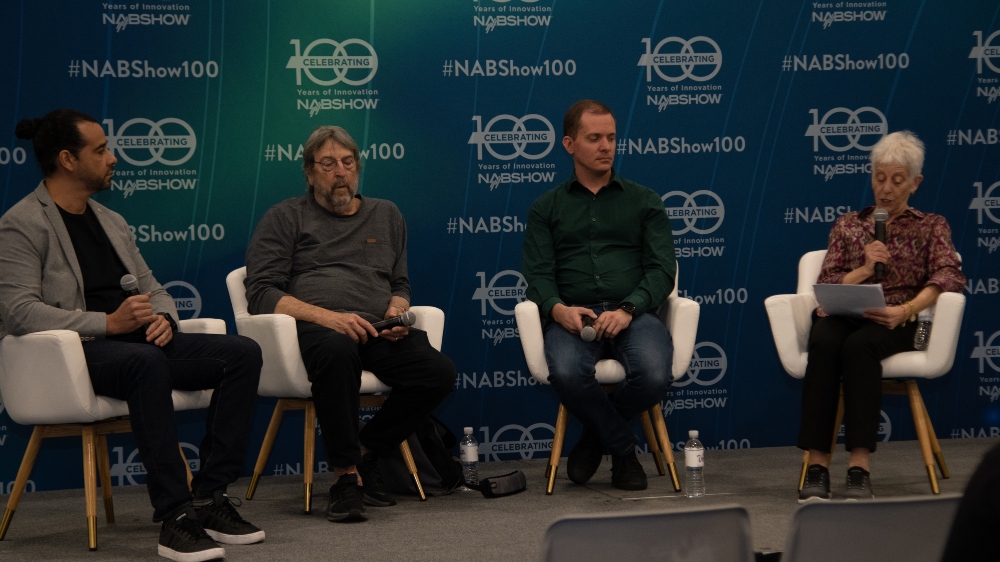An SMPTE panel of color grading experts discussed the current state of cloud-based color grading. FilmLight manager/director, Americas Peter Postma, Colorist Society (CSI) fellow Lou Levinson and AWS senior solutions architect Marlon Campos reported that the workflow for grading in the cloud is now viable. “You can have a proper color grading session,” said Postma, noting that one of the key challenges was color grading’s “sensitivity to latency.” “The important part was making sure the image processing was super low latency.” But latency can come into play when the colorist and the assets are geographically separated. “It doesn’t have to be in the same city, but it has to be deployed relatively closely,” said Postma, who also noted the importance of compression codecs that minimize latency.
Levinson agreed that color grading in the cloud can now be “done well.” “But we have to be careful,” he said. “You have to be very detailed with compression, bandwidth, [and] latency. We’re used to walking into an environment, sitting down at a control surface, and having that direct connection between the brain and the knob. Anything between them hinders the translation of what the director has in mind.”
AWS is currently present in 31 geographic regions, reported Campos. “We have availability zones that are data centers and we have more than 90 data centers around the world, so our customers are as close as possible to their virtual workstations,” he said.
Machine learning tools for color grading in the cloud are beginning to make an appearance. “That’s one of the things I’m here at the show to look at and evaluate,” said Levinson. “There are some potentially very interesting things going on in machine learning and grading. They could give the colorist more power and [the] ability to do things more effectively. The danger is going to be the assumption that it can do everything for you, like the car that can drive itself.”
Postma pointed out that, “one of the advantages of the cloud is to scale the resources to the job at hand.” “The traditional way of building a room is to build the biggest system to accommodate the biggest job that will come in, even if most of the time you’re doing less demanding work,” he explained. “Likewise, it doesn’t make sense to put all the assets in the cloud, color them, and pull them out. If you’re doing a job where you need lots of ML tools, you can easily do that in the cloud. At Filmlight, we bring in ML tools and want our customers to bring their own so the colorist still has complete control over what the ML is doing, not just push a button and see what’s coming out.”
Levinson noted that “when an AI program takes four of your shots and you ask the AI to match them to your color look, there are four or five ways to do that. [But] we can’t expect the computer to do that right now,” he said. Campos reported that, with AWS, “if you are an ML specialist, you can be very geeky using our tools — or you can use a service like Recognition.” “We have three levels of ML services,” he said. “This makes more sense for companies like Filmlight to leverage those series and integrate it into their software.”

When considering why color grading has taken so much longer to move to the cloud, compared to, say, editing, Postma noted that color grading is “the last step in the creative collaboration.” “It’s your last chance to catch a dead pixel or a last-minute make-up fix you need to do,” he said. “If you’re working on a compressed image or have lag, that hinders it. You have a limited time to get the director/DP’s attention for sign-off. What you see has to be representative of the final.”
Campos described the “adventure” of integrating AWS with Filmlight to get to the point it is today. “Our latency now is as low as one frame with a dedicated link — with the Internet, latency as low as three frames,” he said. “The main obstacle was to be able to prove to everyone that it could work — and that the industry is actually looking for what we’re doing.”
Levinson observed that colorists were largely “dragged kicking and screaming” into trying out color grading in the cloud. “And after those experiences, they would tell what they needed to make it better: high-quality image pass, low latency, and the like,” he said. “There was a lot of stress going on.”
“We’re still in the process of getting buy-in from everyone,” admitted Postma. “We have to get to the point where a colorist can’t distinguish between a workstation in the cloud and one that isn’t.” After that, he said, there will be a new set of challenges for support staff and engineers to enable and service the new paradigm. “Cloud coloring makes sense when it comes to dailies in the cloud, [and] VFX in the cloud,” said Postma. “We’re now working on educating people what pieces have to be brought together so it feels no different from working on a local machine.”
Campos said he hears a lot from his customers that colorists ask for testing and proof-of-concept. “What we hear is that they want more vendors supporting the workflow,” he said. “They also want guidance for putting the whole production in the cloud.”
The missing pieces to make this all a reality include “better cybersecurity,” according to Levinson. Postma listed “iterating and improving on what we have,” as well as “education about how to work this way and how to piece together a workflow.” Campos, for his part, agreed. “We really need to make it easier to deploy,” he concluded.





